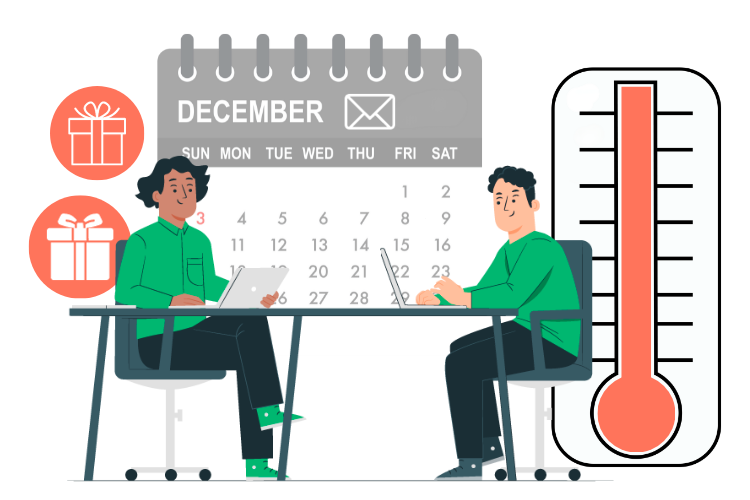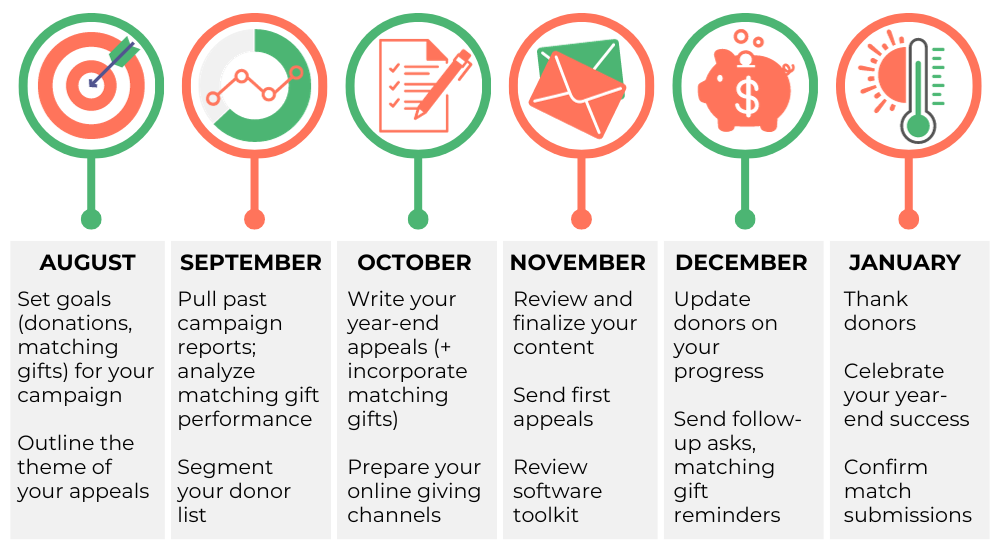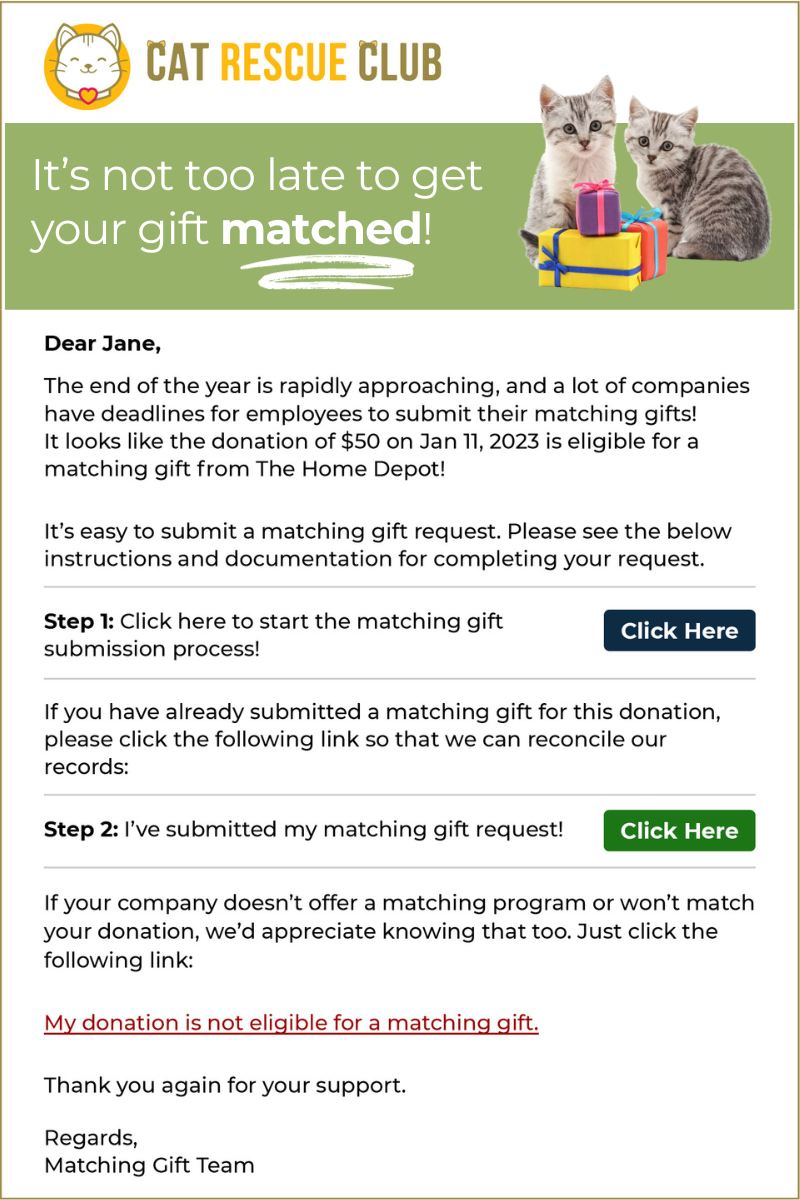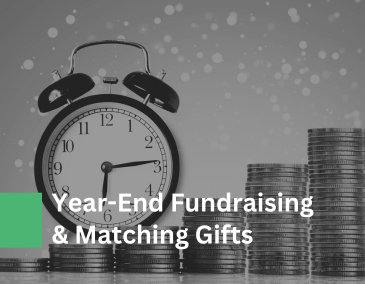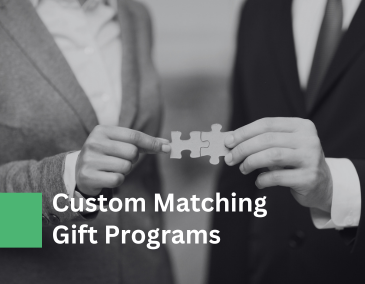Plan your year-end fundraising strategy.
Craft a compelling giving season appeal.
Raise more than ever before.
What Is End-of-Year Fundraising?
Typically occurring in the last four months of the year, a nonprofit’s end-of-year (holiday, giving season, year-end, etc.) campaign is often one of the most important fundraising efforts it initiates throughout the year.
Because an estimated 30% of all annual charitable donations take place in December, the end-of-year fundraising push is a crucial chance to connect with supporters and secure vital fundraising dollars for the year to come.
What Are End-of-Year Appeals?
End-of-year appeals are the specific fundraising asks an organization distributes during the giving season in order to secure last-minute donations. This type of outreach is generally used as a way to solicit support, steward donors, and even pursue year-end matching gift opportunities.
You can send your end-of-year fundraising appeals in a variety of formats through just about any channel. This may include direct mail, email, SMS messaging, and more.
Why Do End-of-Year Appeals Matter?
Just because individuals are more likely to give at the end of the year doesn’t mean they’re automatically going to make their donations to your organization. In order to secure donors’ support for your mission, you’ll need to ask them!
Your year-end appeal is your chance to put your nonprofit at the front of your donors’ minds. This way, when the year-end giving inspiration strikes, your cause will benefit.
How Do Matching Gifts Fit In?
The end-of-year giving season inspires heightened generosity and nonprofit engagement. Highlighting matching gift opportunities is the ultimate way to maximize appeal response rates (by an estimated 71%) and drive up gift sizes (for a 51% increase in your average donation amount).
Not to mention, it’s also a time when many matching gift deadlines close, which can add a sense of urgency to your appeals!
Planning Your End-of-Year Appeal Strategy
1. Create a Year-End Appeal Timeline
The first step to your year-end appeal strategy is to develop a timeline that encompasses the many steps that lead to a successful batch of appeals.
Remember: though you might not send your first letters until November, your end-of-year appeal planning should start much, much earlier!
The more time you give your staff to brainstorm, troubleshoot, and revise your year-end appeal strategy, the more successful your letters are guaranteed to be!
When to Get Started with Matching Gifts:
We recommend incorporating matching gift information directly within your end-of-year appeals and throughout the giving experience. If you send your first round of appeals in November, that’s when you should begin marketing matching gift opportunities, too. Additionally, to pursue unclaimed matches from gifts made in the first eleven months of the year, consider sending year-end matching gift follow-ups in early December.
If you’re looking to build out your fundraising tech stack with a matching gift tool (like Double the Donation), however, it’s a good idea to initiate the software buying process as early as possible. This will ensure you have ample time to make your purchase and get onboarded in time for year-end giving!
2. Segment Your End-of-Year Appeal Mailing List
Segment by Supporter Type
You’ve got a number of different types of constituents stored in your donor database, and it only makes sense to tailor your letters to appeal to each type.
You can create as many segments as you want to send the most specific types of appeal letters possible.
Volunteers, members, and donors can serve as your primary supporter types, but you might also consider event attendees, volunteer committee members, recurring donors, and any other important supporter type.
Segment by Date of Last Gift
If a donor has given in the past month, it may come off as tone-deaf to approach them asking for another gift. Similarly, it wouldn’t make sense to thank a donor who hasn’t given in years for their ongoing support.
Don’t lose a potential donor because of a simple mistake!
For donors who’ve given recently, send a message that’s focused on thanking them and extending their impact (e.g., with matching gifts). For lapsed donors, you may open with “We miss you!” rather than “Thanks for your help.”
Segment by Average Gift Size
The thought process behind making a $10,000 donation is different than making a $10 donation, so why would you send those donors the same appeal? You wouldn’t!
Segment your list by a donor’s average gift size so that each supporter receives a relevant solicitation through the right channel.
For example, it’s appropriate to send an email or direct mailing appeal to a list of small-to-midsized donors, but you should always reach out to major donors or other high-quality prospects in person or over the phone.
And the same findings can be applied to matching gifts, too. You’ll likely take a more personalized approach to pursue a $10,000 match, perhaps by calling or sending a handwritten follow-up. On the other hand, your strategy regarding a $10 match will likely focus on your automated outreach.
Segment by Matching Gift Eligibility
The matching gift portion of your year-end appeal can differ based on a donor’s eligibility for the programs. For example, an existing match-eligible donor could receive an ask that highlights their employer’s willingness to double their gift. It can even provide company-specific program guidelines and submission information.
On the other hand, a supporter with unknown eligibility may be implored to look into the possibility of an employer match. Meanwhile, a known ineligible donor could receive a message that encourages them to advocate for a new match program to their employer.
However, determining matching gift eligibility can get complicated, as informed by nuanced program parameters. Some companies match gifts made by full-time and part-time employees, others are inclusive of retirees, and others still apply to eligible spouses! Thus, the simplest way to identify the nitty gritty details is by enlisting an automated database tool.
3. Identify the Right Tools to Power Your Year-End Appeals
Integrated Features
As you know, your end-of-year appeal strategy is made up of a lot of moving parts in multiple areas of your nonprofit. Luckily, software can help with all of your efforts!
Rather than working with separate software solutions to tackle each facet of year-end appeals, it’s best to build a comprehensive software ecosystem tool that can streamline appeals from start to finish.
You should search for software with integrated features to help you stay on top of direct mail appeals, email marketing, analytics, matching gifts, and (most importantly) the fundraising campaign itself.
Task Automation
You’ll be busy during the year-end season, but you can’t risk letting any important activities fall through the cracks when it comes to sending, tracking, and following up on appeals.
When you use software that can automate a number of tasks, you’ll have a much easier time managing the diverse array of responsibilities that make up your year-end appeal efforts.
From follow-up or reminder emails to donor data entry, your software should make it easy to manage the minute details of your year-end campaign seamlessly (and with as little human error as possible).
Customization Capabilities
You want your end-of-year campaign to be unique to your nonprofit, and software with comprehensive customization capabilities can facilitate that!
Look for a software solution that can help your nonprofit create custom direct mailings, email campaigns, year-end donation forms, and more that fits seamlessly into your overall strategy.
Remember: you shouldn’t have to be a coding expert or graphic design aficionado to create professional and visually appealing end-of-year appeals. With the right software, your fundraising team should be equipped to build a comprehensive campaign reflective of your brand and mission.
Reporting and Analytics
There’s no way to assess and improve your year-end efforts without first measuring which strategies have worked and which have fallen short in the past.
Thus, your fundraising and marketing software should have built-in reporting and analytics functionality. These features should let you tap into the success of your year-end appeals, allowing you to design more effective and data-informed strategies going forward.
Most software solutions come with preset reports that track common metrics. However, it’s equally important that you can build out custom reports and presentation styles based on any conditions you need.
Matching Gift Functionality
Leading up to the year-end giving season (or just about any other time of the year), a key consideration in your fundraising tech stack should be matching gift functionality. After all, corporate matching gifts present organizations with an invaluable funding boost, but often go unclaimed due to a lack of a dedicated strategy with which to pursue the opportunity.
The industry’s #1 matching gift automation platform, Double the Donation, can help. And when an organization utilizes Double the Donation, it can be seamlessly incorporated into other year-end fundraising initiatives. In fact, through powerful software integrations with more than 90 of the industry’s leading fundraising solutions, nonprofits can automate the process of identifying match-eligible gifts within the donation process, facilitate one-click auto-submissions, trigger tailored follow-up messaging, and track corporate matches to completion.
4. Draw From Prior Year-End Campaign Data
Your year-end campaign strategy needs attainable, ambitious goals in order to define and measure success. A great way to develop strategic objectives for your end-of-year appeals is to look at the results of past campaigns. Then, set your sights a bit higher to encourage continuous growth.
In order to build out comprehensive reports and make the most of the data available to you, you’ll need to use nonprofit software that allows you to tap into all the areas that make up your multifaceted year-end campaign. And in cyclical fashion, the data your efforts produce this year can help inform your fundraising plan next giving season!
This might include:
5. Prepare Your Year-End Donation Forms
Integrate Donation Forms with Your CRM
You’ll be collecting a lot of donor data within your giving pages during the year-end fundraising season, largely due to increased web traffic and donor generosity. Cut down on manual data entry by integrating your online donation form with your CRM tool so that all information can seamlessly flow into your supporter database.
Brand Your Year-End Donation Page
Create a unique online giving form that corresponds to your broader year-end and other fundraising efforts, with consistent branding elements such as colors, fonts, and images. Your year-end fundraising campaign has a story, and it’s important that you visually convey that message at every point—such as your donation form and matching gift widget!
Make Your Donation Form Mobile-Responsive
Let donors make their year-end gift whether they’re at home by the fire or out making a last-minute shopping trip. Working with mobile-friendly online donation software can ensure supporters can easily submit a donation on a smartphone or any other mobile device. (If applicable, this should include your matching gift tool, too!)
Collect Employer Info to Identify Matches
When it comes to identifying matching gift opportunities in your donor base, the most important piece of information pertains to where your supporters work. And your donation page is one of the best places to request employment data! Consider embedding a matching gift employer search tool or collecting plain-text company names (though the latter will require more manual effort for your team).
Include Specific Year-End Giving Levels
Your donors don’t have time to ruminate on the right gift amount. Do the hard work for them by providing suggested donation amounts that correspond with your year-end campaign goals. For example, a $50 donation might provide 10 meals out of the 100,000 you’re hoping to achieve by the end of the year. We recommend offering 3-5 recommended gifts while retaining the option for donors to select their own if they’d rather.
Writing Your End-of-Year Appeal Letters
6. Tell a Compelling Story Within Your End-of-Year Appeal
Make Your Story Personal
When possible, use real name (or pseudonym) of a beneficiary who’s been positively impacted by your mission. Incorporating other details, such as age or location, can also help ground your story in reality and make it more meaningful for the reader.
Even better? Allow your subjects to speak for themselves! Add a quote or, in the case of video appeals, let them narrate their own story. This can give your end-of-year appeal a heartfelt element you can’t fabricate.
Don’t Overdo It
You’re passionate about the work your nonprofit is doing, so it’s not hard to get caught up in the story you’re telling! But when it comes to storytelling, you need to get in and out fast—before you lose the reader’s focus.
Jump to the meat of your story in the first or second paragraph of your appeal, and don’t spend more than two short paragraphs telling your tale. The faster you can get to your call to action, the less likely your donors will move on to other things that are vying for their attention.
Add a Visual Element
It’s tough to capture someone’s attention in a few black-and-white text paragraphs. To draw a reader in and help foster a connection with your story, you’ll need to add some visual aids. You’ve heard the saying: a picture’s worth a thousand words!
An image or video complementing your story can be much more powerful than text alone. Show your donors exactly what your nonprofit has done this year, whether that’s a healthy animal you’ve rescued or a beautiful community garden you’ve grown.
Communicate Matching Impact
Donors love to see their dollars making a tangible difference in the lives of those who benefit from an organization’s services. Supporters typically give because they have a passion for your mission, and producing a greater impact can deepen their connection with your cause.
That’s where matching gifts really come in handy! Framing your year-end appeal asks as a possibility for donors to have twice the effect can go a long way. In your matching gift messaging, remember to reiterate the greater difference donors can make by participating in their employers’ match programs.
7. Focus on the Donor in Your End-of-Year Appeals
Instead of lauding your own accomplishments, frame the letter so that the donor is actively responsible for your nonprofit’s impact. Show your donors you value their generosity on an individual level by specifically referencing what they’ve already done for your cause. For example, you might call out a recent donation, matching gift, or volunteer event and explain how their engagement has made a difference. Remind donors that their donations, volunteer efforts, matching gifts, and mission advocacy are what make your mission possible. They’ll be more likely to get involved again!Use "You" Language
Reference Past Involvement
Emphasize the Value of Their Support
Examples of Donor-Focused Content
- “Generous supporters like you provided over 10,000 warm meals to our community last year.”
- “Thanks to your generous gift of $250 last year, 5 underprivileged children received school supplies.”
- “Because of your ongoing financial support, we’ve raised $100,000 for families in need.”
- “Without hardworking volunteers like you, we couldn’t keep our shelter running. Thank you!”
- “Here’s how you can extend your impact and continue making a difference in our community.”
- “We’re working to make a lasting change for homeless youth, but we can’t do it without your help.”
- “Your matching gift provided additional funds for our mission, providing more beneficiaries with much-needed food and resources.”
8. Include Matching Gift Information in Year-End Appeals
Matching gift programs are one of the most popular types of corporate philanthropy wherein corporations match gifts their employees make to eligible nonprofits. Often at a dollar-for-dollar rate (but sometimes going as high as 2:1, 3:1, or even 4:1), matching gifts essentially provide organizations with a “Buy One, Get One Free” sale on nonprofit fundraising. And donors love getting involved in the programs as they’re able to produce a greater value without having to reach back into their own wallets to do so. Before you can promote matching gifts effectively to your donors, it helps to get your whole internal fundraising team on the same page with the programs. Luckily, Double the Donation provides a wide array of helpful resources to do so—including our top recommendation, the online Matching Gift Academy. (Hint: current Double the Donation clients can access the Academy content for free or non-clients can enroll for $199/year.) Additionally, our team offers live and on-demand webinars, blog posts, downloadable guides, and more as a way to equip organizations like yours with educational materials. Ahead of the giving season is a great time to jump in! One of the leading causes of the matching gift funding gap is a lack of awareness among donors regarding the opportunity. To increase knowledge of corporate matching, it’s important to make it as easy as possible for individuals to identify their own program eligibility. One of our favorite ways includes placing a matching gift database search tool on your donation page and within year-end communications. Donors simply enter their employer’s name and uncover the important program criteria, deadlines, and submission forms for their company. Other ideas include sharing information on social media, in supporter newsletters, and prominently on your nonprofit website, following up on match-eligible donations, and more.What are the benefits of matching gifts?
How can you prepare your team for year-end matching gift efforts?
How can you educate donors on matching gifts?
Many matching gift deadlines fall at the end of the calendar year or the following January. By reminding donors that they have a limited window of time to double their gift, you can establish a sense of urgency that drives supporters to take actionable next steps. Not to mention, the year-end season produces heightened levels of generosity and nonprofit engagement. As a result, individuals often seek new and impactful ways to support their favorite organizations. Matching gifts are a perfect way to do so! See it in action! Take a look at how this fundraiser promotes matching gifts using Double the Donation’s automated year-end email stream.Why do matching gifts and year-end appeals work well together?
9. Personalize Your End-of-Year Appeals
Donors know they’re not the only person receiving your end-of-year fundraising appeal, but that doesn’t give you a license to send out hundreds of identical letters or emails.
After all, your supporters are much more than a name on a mailing list or a record in your CRM. Adding personalized elements to your outreach lets the recipient know that you understand this, making it easier for them to connect with your appeal.
In other words, by tailoring your appeal in a variety of ways, you can emphasize how highly you value each donor.
So use the information available in your database to make each solicitation unique to its recipient. Before you start distributing appeals, however, consider conducing a thorough database cleanup to ensure all names, contact information, and giving histories are accurate and complete.
Elements to Personalize in Your Appeal
Executing Your End-of-Year Appeal Strategy
10. Take a Multi-Channel Year-End Appeal Approach
Write a Year-End Appeal Letter
The most classic end-of-year appeal style out there, the direct mail appeal letter is a standard because of its personal touch and reliable success rate.
For best results with end-of-year fundraising letters, start with an expert-crafted appeal template and personalize it for your mission from there. You can even streamline your efforts with direct mail marketing software that allows you to design, write, send, and track your appeals.
Send Year-End Email Appeals
Taking a more modern approach to the standard year-end appeal, email outreach allows your team to benefit from increased efficiency and decreased costs. All you need is a trusty email marketing software and a list of donors to whom you send your appeals!
Keep in mind that your supporters likely receive dozens of emails per day (if not more!), and you’re probably not the only nonprofit soliciting their inbox come December. Keep your email appeal short and sweet, with an eye-catching subject line and a clear call to action within the body of your message.
Promote Your Year-End Appeal Using Paid Advertising
Paid advertising is an emerging trend in the nonprofit sector, empowering teams to increase visibility for their causes, target specific audiences, and drive year-end fundraising results.
Google and Microsoft even make it easy for nonprofits to leverage paid advertising for free. Using programs like Google Ad Grants and Microsoft Ads for Social Impact, you can promote your web content at the top of search results for terms your prospects are looking into on search engines.
Mail Year-End Appeal Postcards
Similar to an appeal letter, the end-of-year postcard is the perfect option for capturing donors’ attention as they retrieve their mail. And it allows you to bypass one of the greatest barriers to direct mail appeals: getting your envelope opened!
You’ll want to focus heavily on design and branding for your postcard appeals. Using bright imagery, a high-quality photo or two, and heavy, professional-quality cardstock will go a long way here.
Perhaps most importantly, don’t forget to prominently place the URL or QR code for your online donation form so donors can’t miss it.
Post Year-End Appeals on Social Media
If your nonprofit has a significant digital presence, make sure all of your fans and followers are well aware of your year-end fundraising by sharing information about your campaign on your social media pages.
Although these posts shouldn’t be your only end-of-year solicitation effort, they can be a great way to raise awareness and boost donations. Use highly visual mediums (like photos and videos) to stand out on a news feed, and don’t forget to link to your online donation form or provide your text-to-give phone number.
(Top tip: it’s also an excellent opportunity to share matching gift information with supporters who may be unaware of the programs!)
Stand Out With Year-End Fundraising eCards
Another digital strategy that’s increasing in popularity among nonprofits is fundraising eCards. Similar to an online postcard or greeting card, eCards allow organizations to engage with supporters via a short and sweet, visually appealing message. And they can be sent via email or SMS text message, allowing nonprofits to reach their supporters wherever they are.
On the other hand, eCards can also work well alongside other types of appeals as a way to thank donors for their generous support.
11. Get Your Board Involved with Your End-of-Year Appeal Strategy
Your board of directors likely plays an important role in your nonprofit’s fundraising efforts. By serving as powerful advocates for your cause (and often as the face of your nonprofit), your board members can elevate your year-end fundraising appeals and persuade donors to give more than ever before.
The best part? Your board members want to help!
You already know that your board members are devoted to your cause and looking for ways to engage themselves. However, it’s up to your nonprofit staff to delegate the right activities and responsibilities— and equip board members with the training and tools they need to follow through effectively.
Take time in the pre-Giving Season period to outline clear tasks (and associated timelines for completion) that you want board members to take on. Like any other volunteer, the more direction you can provide a board member, the more likely they are to succeed!
12. Offer Multiple Ways to Make an End-of-Year Gift
Mobile Giving and Text-to-Give
An online donation form is a good start, but to maximize giving opportunities, be sure to optimize your efforts for all screen sizes! For example, by creating a mobile-friendly giving page that supporters can quickly complete on any device.
You can also take mobile giving to the next level with text-to-give software! This allows you to establish a designated phone number or shortcode and a campaign-specific keyword to accept year-end gifts. From there, donors simply text their donation amount to make a quick and easy gift.
Corporate Giving
We’ve already discussed the importance of matching gifts during end-of-year fundraising, but did you know there are even more corporate philanthropy programs your donors should be aware of?
Through volunteer grants, giving stipends, corporate sponsorships, and more, your donors can make their year-end gift go even further. Be sure to educate your supporters on these additional opportunities to make sure you’re meeting your full year-end fundraising potential. And you can use your existing data to uncover broader corporate partnerships, too!
Peer-to-Peer Fundraising
If your nonprofit is hosting a year-end fundraising event, why not add some friendly competition to the mix through peer-to-peer fundraising?
A P2P or social fundraising platform will equip your supporters to set up their own fundraising pages and solicit year-end donations from their peers. This empowers your nonprofit to extend its online reach to new prospects and raise more money and awareness during the end-of-year season!
In-Kind Gifts
Not all donations are monetary, either, and opening up your year-end appeals to be inclusive of in-kind gifts can be a great way to scale up your fundraising results.
In-kind donations, or any “non-financial” gift to a nonprofit, may encompass goods (e.g., clothing, food, technology, office supplies) and services (pro bono marketing assistance, legal aid, or tax services).
Consider hosting a year-end food or clothing drive to make the most of this strategy!
Stock Donations
More and more organizations have begun to accept gifts of securities (such as stocks, mutual funds, and other marketable securities) as a way for donors to support the nonprofit’s cause. But many still overlook this giving opportunity!
Including stock donations in your year-end fundraising materials can be a great way to increase giving through this channel. Not to mention, many companies will now even match employees’ stock donations, allowing these gifts to count twice.
13. Follow Up on Your Year-End Appeals
Immediately following a donor’s gift, send an acknowledgment email that confirms their donation and provides a tax receipt. Especially for year-end gifts, donors will need this information for their own financial records. This, you’ll want to ensure these messages are automated and triggered in a timely manner. Show donors how much you appreciate their contributions by sharing a personal thank-you note. If possible, send high-value and long-standing donors a handwritten note signed by a board member to provide a personal touch. For other supporters, consider a personalized email acknowledgment.Confirm the Donation
Thank Supporters
If a donor doesn’t respond to your first (or second) appeal, it may be time to follow up over the phone. To coordinate with board members and other volunteers, we recommend segmenting your list by ask size and prioritizing your highest-quality prospects first. After donors give, make sure you have their data accurately stored within your database. If you need more data than your giving form collects (e.g., an individual opted not to complete the employer field), consider sending a follow-up email in a few weeks. This can serve as an extra touchpoint, encouraging the recipient to provide additional information and complete their donor profile.Call Unresponsive Donors
Store Data for Future Use
SEND MATCHING GIFT REMINDERS
Some donors will likely submit their matching gifts immediately after their year-end donations. But many ultimately won’t—and an automated matching gift reminder can be just what they need to inspire their next steps.
For the best results, we recommend triggering follow-ups within 24 hours of a donor’s initial gift being made. And if you have employment information on record, providing company-specific program guidelines and links to submission forms can go a long way in guiding donors through the participation process.
Additional Year-End Fundraising Resources
Year-End Fundraising and Matching Gifts
Corporate matching gifts and end-of-year appeals go hand-in-hand for nonprofit fundraisers. And it’s not too late to craft or finetune your strategy now!
Check out our complete guide to matching gifts in the year-end fundraising season to guide your way.
Double the Donation’s Matching Gift Academy
Prepare your whole team for smart end-of-year and matching gift fundraising efforts with the industry’s first and only Matching Gift Academy.
Explore our online learning system to get the most out of matching gifts for your mission this season.
What to Know About Custom Matching Gifts
Did you know that the year-end giving period is a popular time for custom matching gifts? Unlock additional support with these powerful and unique program opportunities.
See how you can pursue these types of one-on-one partnerships with our guide to the topic here.
